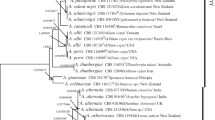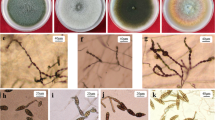Abstract
Carob (Ceratonia siliqua L.) leaves showing suspected symptoms of Ceratonia Blight disease were collected from both wild and domestic carob plants at various locations in the province of Antalya in Turkey. The fungus growing on culture medium started as white-grayish airy mycelium at the margin with clear light to dark green inner zonation radiating from a common center. Dark brown conidia in chains were observed ranging in sizes from 5 to 35 μm. The conidia surface was smooth to verruculose, slightly constricted with 4–6 transverse septa; the lower part of each portion had one or two longitudinal septa. The conventional PCR was conducted based on the beta tubulin gene and ITS region, which resulted in fragment sizes of 184 bp and 346 bp, respectively. The amplified PCR products were sequenced aligned and BLAST analysis showed 100% homology for the two genes with other strains from the GenBank nucleotide database. The isolates also tested positive with SYBR Green fluorescence dye using Real-Time PCR. The results of the disease incidence recorded across the fields ranged from 10 to 100% on both wild and domesticate carob plants. The putative pathogen was pathogenic on the inoculated carob plants and was consistently re-isolated from the symptomatic plant leaves and thereby satisfying the Koch’s postulates. Based on our knowledge, this is the first report implicating Alternaria alternata for causing Ceratonia Blight disease in Turkey.








Similar content being viewed by others
References
Altschul, S. F., Gish, W., Miller, W., Myers, E. W., & Lipman, D. J. (1990). Basic local alignment search tool. Journal of Molecular Biology, 215, 403–410.
Bansal, V. K., Kharbanda, P. D., Stringam, G. R., Thiagarajah, M. R., & Tewari, J. P. (1994). A comparison of greenhouse and field screening methods for blackleg resistance in doubled haploid lines of Brassica napus. Plant Disease, 78, 276–281.
El-Gali, Z. I. (2015). The causative of leaf spot on carob-isolation and identification. European Journal of Botany Plant Sciences and Pathology, 2, 11–18.
FAO. (2013). FAO statistics division. http://www.fao.org/home/en/. Accessed 25 Feb 2016.
Gingeras, T. R., Higuchi, R., Kricka, L. J., Lo, Y. M., & Wittwer, C. T. (2005). Fifty years of molecular (DNA/RNA) diagnostics. Clinical Chemistry, 51(3), 661–671.
Goll, R., Olsen, T., Cui, G., & Florholmen, J. (2006). Evaluation of absolute quantitation by nonlinear regression in probe-based Real-Time PCR. BMC Bioinformatics, 7, 107.
Hall, T. (1999). BioEdit: a user-friendly biological sequence alignment editor and analysis program for Windows 95/98/NT. Nucleic Acids Symposium Series, 41, 95–98.
Hillcoat, D., Lewis, G., & Verdcourt, B. (1980). A new species of Ceratonia (Leguminosae-Caesalpinoideae) from Arabia and the Somali Republic. Kew Bulletin, 35(2), 261–271.
Howlett, B. J. (2006). Secondary metabolite toxins and nutrition of plant pathogenic fungi. Current Opinion in Plant Biology, 9, 371–375.
Jasalavich, C. A., Morales, V. M., Pelcher, L. E., & Seguin-Swartz, G. (1995). Comparison of nuclear ribosomal DNA sequences from Alternaria species pathogenic to crucifers. Mycological Research, 99, 604–614.
Kang, J. C., Crous, P. W., Mchau, G. R., Serdani, M., & Song, S. M. (2002). Phylogenetic analysis of Alternaria spp. associated with apple core rot and citrus black rot in South Africa. Mycological Research, 106, 1151–1162.
Khair, M., El-Shatnawi, J., & Ereifej, K. I. (2001). Chemical composition and livestock ingestion of carob (Ceratonia siliqua L.) seeds. Journal of Range Management, 54, 669–673.
Kimura, M. (1980). A simple method for estimating evolutionary rate of base substitutions through comparative studies of nucleotide sequences. Journal of Molecular Evolution, 16, 111–120.
Konstantinova, P. P., Bonants, J. M., Van Gent-Pelzer, M., Van Der Zouwen, P., & Van Der Bulk, R. (2002). Development of specific primers for detection and identification of Alternaria spp. in carrot material by PCR and comparison with blotter and plating assays. Mycological Research, 106, 23–33.
Kordalewska, M., Brillowska-Dąbrowska, A., Jagielski, T., & Dworecka-Kaszak, B. (2015). PCR and real-time PCR assays to detect fungi of Alternaria alternata species. Acta Biochimica Polonica, 62(4), 707–712.
Kusaba, M., & Tsuge, T. (1995). Phylogeny of Alternaria fungi known to produce host-specific toxins on the basis of variation in internal transcribed spacers of ribosomal DNA. Current Genetics, 28, 491–498.
Lawrence, D. P., Gannibal, P. B., Peever, T. L., & Pryor, B. M. (2013). The sections of Alternaria: formalizing species-group concepts. Mycologia, 105, 530–546.
Madden, L. V., Hughes, G., & Van den Bosch, F. (2007). The study of plant disease epidemics. St. Paul: The American Phytopathological Society, APS Press, pp. 421.
Maraite, H., Di-Zinno, T., Longree, H., Daumerie, V., & Duveiller, E. (1998). Fungi associated with foliar blight of wheat in warm areas. In E. Duveiller, H. J. Dubin, J. Reeves & A. McNab (Eds.), Proceedings ofthe International Workshop Helminthosporium Disease of Wheat: Spot Blotch and Tan Spot (pp. 293–300). El Batan: CIMMYT.
Mirkova, E., & Konstantinova, P. (2003). First report of Alternaria leaf spot on gerbera (Gerbera jamesonii H. Bolux ex J. D. Hook) in Bulgaria. Journal of Phytopathology, 151, 323–328.
Muthulakhsmi, P. (1990). Studies on fruit rot of chillies (Capsicum annum L.) caused by Alternaria tenuis Nees. M.Sc. Thesis. Tamil Nadu Agricultural University, India. p. 139.
Nagrale, D. T., Gaikwad, A. P., Goswami, S., & Sharma, L. (2012). Fungicidal management of Alternaria alternata (Fr.) Keissler causing blight of gerbera (Gerbera jamesonii H. Bolus ex J.D. Hook). Journal of Applied and Natural Science, 4(2), 220–227.
Narain, A., Swain, N. C., Sahoo, K. C., Dash, S. K., & Shukla, V. D. (1985). A new leaf blight and fruit rot of watermelon. Indian Phytopathology, 38(1), 149–151.
Neergaard, P. (1945). Danish species of Alternaria and Stemphylium (p. 560). London: Oxford Univ. Press.
Nishimura, S., & Kohmoto, K. (1983). Host-specific toxins and chemical structures from Alternaria species. Annual Review of Phytopathology, 21, 87–116.
Nolan, T., Hands, R. E., & Bustin, S. A. (2006). Quantification of mRNA using Real-Time RT-PCR. Nature Protocols, 1(3), 1559–1582.
Orwa, C., Mutua, A., Kindt, R., Jamnadass, R., & Simons, A. (2009). Agroforestree database:a tree reference and selection guide version 4.0. http://www.worldagroforestry.org/af/treedb/.
Oviedo, M. S., Sturm, M. E., Reynoso, M. M., Chulze, S. N., & Ramirez, M. L. (2013). Toxigenic profile and AFLP variability of Alternaria alternata and Alternaria infectoria occurring in wheat. Brazilian Journal of Microbiology, 44, 447–455.
Pandey, K. K., & Vishwakarma, S. N. (1999). Morphological and symptomatological variations in Alternaria alternata causing leaf blight in brinjal. Journal of Mycology and Plant Pathology, 29, 350–354.
Rao, V. G. (1965). Alternaria leaf spot of rose from India. Mycopathologia et Mycologia Applicata, 27(1–2), 129–133.
Rotem, J. (1994). The genus Alternaria: biology, epidemiology, and pathogenicity. St. Paul: APS Press.
Sahle, M., Coleon, J., & Haas, C. (1992). Carob pod (Ceratonia siliqua) meal in geese diets. British Poultry Science, 33, 531–541.
Sekeri-Pataryas, K. H., Mitrakos, K. A., & Georgi, M. K. (1973). Yields of fungal protein from carob sugars. Economic Botany, 27, 311–319.
Sharma, M., Ghosh, R., & Pande, S. (2013). Occurrence of Alternaria alternata causing Alternaria blight in pigeonpea in India. Advances in Bioscience and Biotechnology, 4, 702–705.
Simmons, E. G. (1992). Alternaria taxonomy: current status, viewpoint, challenge. In J. Chelkowski & A. Visconti (Eds.), AIternaria: biology, plant diseases and metabolites (pp. 1–35). Amsterdam: Elsevier.
Simmons, E. G. (2007). Alternaria. An Identification Manual: CBS Biodiversity Series No. 6. CBS Fungal Biodiversity Centre, Utrecht, the Netherlands 775.
Simmons, E. G., & Roberts, R. G. (1993). Alternaria themes and variations. Mycotaxon, 48, 109–140.
TUIK. (2015). http://www.tuik.gov.tr/Start.do . Accessed 27 July 2016.
Vardar, Y., Seçmen, Ö., & Öztürk, M. (1980). Some distributional problems and biological characteristics of Ceratonia in Turkey. Portugaliae Acta Biologica, 16(1–4), 75–86.
White, T. J., Bruns, T., Lee, S., & Taylor, J. W. (1990). Amplification and direct sequencing of fungal ribosomal RNA genes for phylogenetics. In M. A. Innis, D. H. Gelfand, J. J. Sninsky, & T. J. White (Eds.), PCR Protocols: A Guide to Methods and Applications (pp. 315–322). Academic Press: New York.
Whiteside, L. (1981). The carob cookbook. Ed. Wellingborough: Thorsons Publishers Limited.
Woudenberg, J. H. C. (2015). Restyling Alternaria. Wageningen University, (pp. 250). Wageningen, The Netherlands.
Woudenberg, J. H. C., van der Merwe, N. A., Jurjevic, Z., Groenewald, J. Z., & Crous, P. W. (2015). Diversity and movement of indoor Alternaria alternata across the mainland USA. Fungal Genetics and Biology, 81, 62–72.
Zhang, T. Y. (2003). Flora Fungorum sinicorum. Alternaria (p. 16). Beijing: Science Press.
Acknowledgments
Our profound gratitude goes to Doğancan Aktaş, of the Department of Plant Protection, Akdeniz Unıversity, for his technical contribution during laboratory and field works.
Author information
Authors and Affiliations
Corresponding author
Ethics declarations
Conflict of interest
The authors declare that they have no conflict of interest.
Rights and permissions
About this article
Cite this article
Basım, H., Basım, E., Baki, D. et al. Identification and characterization of Alternaria alternata (Fr.) Keissler causing Ceratonia Blight disease of carob (Ceratonia siliqua L.) in Turkey. Eur J Plant Pathol 151, 73–86 (2018). https://doi.org/10.1007/s10658-017-1354-y
Accepted:
Published:
Issue Date:
DOI: https://doi.org/10.1007/s10658-017-1354-y




